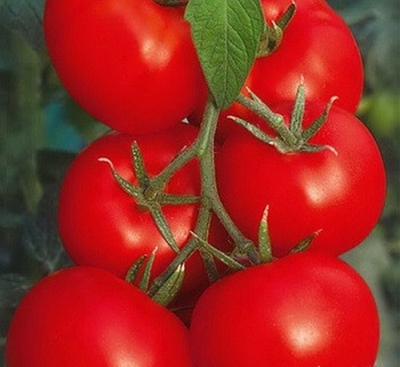
- Category: grade
- Growth type: semi-determinant
- Appointment: universal
- Ripening period: early
- Ripening time, days: 100-105
- Growing conditions: for open ground, for closed ground
- Bush height, cm: 120-150
- Ripe fruit color: Red
- Fruit shape: rounded
- Fruit weight, g: up to 100
Sweetness is the quality of tomatoes for which many people plant them. However, not everything is so simple, and each variety deserves careful study. Tomato Sugar mouth will have to be considered deeply and comprehensively before you can benefit from its bushes.
Description of the variety
Such a tomato is classified as a semi-determinate variety. Its application is universal. Such a culture will grow equally effectively in a regular garden and in a greenhouse. The bushes reach a height of 1.2-1.5 m.
The main qualities of the fruit
Typical for them:
Red color;
rounded overall shape;
weight up to 100 g.
Taste characteristics
The flesh of the Sugar Mouth stands out for its juiciness. And yes, this is indeed a sweet tomato variety. It fully lives up to its name.
Ripening and fruiting
This is the standard early variety. After throwing out the seedlings, the time to harvest comes in 100-105 days. More precisely, it can be determined only taking into account the specific growing conditions of specific plants. It is also important to take into account the fact that the duration of fruiting is not specified in the official description.
Yield
Sugar Mouths are pretty productive. The fruits ripen together. During the first month of fruiting, the bush will give about 80% of the final harvest. For 1 sq. m you will get an average of 6-8 kg of berries. The result may depend on the weather and on how carefully and conscientiously they approach gardening work, but in most cases it pleases.
The timing of planting seedlings and planting in the ground
Sugar Mouth seeds are sown in containers or plain boxes most often during March. But it is quite possible to do this even in the first ten days of April. The decisive reference point for gardeners should be the weather conditions and their own agricultural skills. Transfer to greenhouse places takes place during April-May. If it is decided to breed this culture in the open air, then we must wait until June; it is very important to monitor the actual weather and assess the heating of the earth.

Growing tomato seedlings is an extremely important process, because it largely depends on whether the gardener will be able to harvest at all. All aspects must be taken into account, from seedbed preparation to planting in the ground.
Landing scheme
The official seed supplier insists on using the 300x500 mm system. There is simply no sense in looking for any other options, respectively.

Growing and care
Sugar Mouth is a plant that produces a large number of shoots.Therefore, you will need to systematically pinch him. The garter to the usual supports is also justified. The bush is most often formed into 2 or 3 stems. The choice between these options must be made by the gardeners themselves, taking into account their specific considerations.
This variety tolerates waterlogging of the earth well and does not crack. However, this is not a reason to arrange such an extreme test on purpose. It is better to observe the irrigation regime completely. When the berries are ripe, the bushes need more water than usual. It must be remembered that Sugar Mouth is a light-loving culture.
In addition to removing stepchildren, it is necessary to fight with excess foliage. Insect control is provided by commonly used insecticides. There are no special recommendations for their use, except for following the instructions. In the northern regions and edges of the Russian Federation, a greenhouse or greenhouse planting is recommended. In most of the territory of Russia, however, this variety grows well in a simple vegetable garden.
Seeds are traditionally disinfected before planting. The bottom of the box is laid with a drainage layer. Sowing seedlings is accompanied by thorough spraying from a spray bottle. Even before transshipment to the final place, it is necessary to water the seedlings with dissolved mineral complexes 2 or 3 times. At the time of transplantation, the seedlings are deepened so that their lateral roots develop better.
Other recommendations:
in the first week after the pick, avoid watering and fertilizing;
plant the plant in small holes;
tie bushes to supports under 3 sheets;
water the plantings of Sugar Mouth every 5-7 days or after the top layer of the earth has dried;
every 14 days, feed the plants with a universal tomato feed.




A plant needs different micronutrients at each stage of growth. All fertilizers can be divided into two groups: mineral and organic. Folk remedies are often used: iodine, yeast, bird droppings, eggshells.
It is important to observe the rate and period of feeding. This also applies to folk remedies and organic fertilizers.
Disease and pest resistance
The extent to which this plant is resistant to damage by diseases and harmful insects is not specified even on the official resources of manufacturers and suppliers. The conclusion is obvious - a full-fledged prophylaxis is needed, as for most representatives of the nightshade family. In addition to the use of special preparations, agrotechnical preventive measures are also important.


Resistant to adverse weather conditions
The ability to develop well on cloudy days is declared for this variety. And he also tolerates the summer coolness relatively well - unless it turns into severe cold. Therefore, gardeners should still exercise discretion. With reasonable care, such a culture shows itself well even in the Urals and Siberia. The more is the chance to achieve a good harvest in softer regions.

























































































